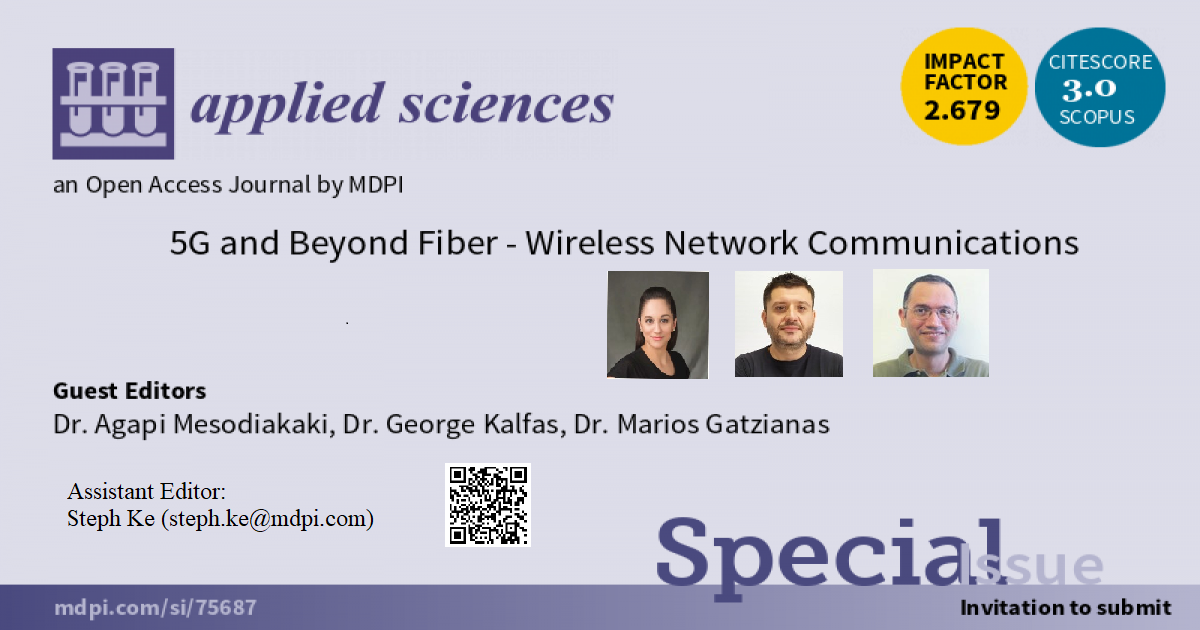- 2.5Impact Factor
- 5.5CiteScore
- 20 daysTime to First Decision
5G and Beyond Fiber-Wireless Network Communications
This special issue belongs to the section “Optics and Lasers“.
Special Issue Information
Dear Colleagues,
To unleash the full potential of 5G communications and to prepare the ground for beyond 5G (B5G) communications, the joint study and optimization of the optical and wireless network domains is expected to play a key role. New 5G service requirements, such as high network capacity and ultra-reliable and low-latency communications, supporting a massive number of connections and others, are shaping the evolution not only of the wireless radio component but, also, of the optical wired segments, spanning from access to core network. On a longer-term horizon pointing towards 5G and B5G, new challenging technical directions are arising that promise to revolutionize users’ network experience. While this is a vision and the exact service definitions are still to be provided, it is certain that next-generation service requirements will be further intensified across all fields of network specifications, i.e., capacity, latency, reconfigurability, reliability, and security, and as such simple upscaling of the present wireless and optical networks infrastructure is not a viable solution. A redesign that features sublinear service scaling costs, extreme bitrates, and low-latency guarantees, with in-built software and hardware security at the component and system level in addition to automated reconfigurability, will be needed. The latter will be facilitated by even greater network softwarization and virtualization of critical infrastructure enabling, among others, zero-touch network configuration, resource sharing among operators, and much higher economies of scale than is currently possible. To support the user-centric communication paradigm introduced with 5G, enhanced and computationally efficient artificial intelligence (AI)/machine learning (ML) algorithms also need to be developed to predict user behavior and demands and, consequently, dynamically adapt the communication path, even proactively, in real-time. Hence, new and possibly disruptive solutions must be investigated across the optical and wireless domains, both for the data and the control planes.
For this Special Issue, we invite submissions exploring converged optical and wireless B5G network functionalities in a variety of topics. Contributions can focus on techniques and resource allocation algorithms, design, analysis, and management of virtualized networks, security and resilience, end-to-end network performance optimization, or cross-layer optimization strategies for B5G networks. Survey papers and reviews are also welcomed.
Dr. Agapi Mesodiakaki
Dr. George Kalfas
Dr. Marios Gatzianas
Guest Editors
Manuscript Submission Information
Manuscripts should be submitted online at www.mdpi.com by registering and logging in to this website. Once you are registered, click here to go to the submission form. Manuscripts can be submitted until the deadline. All submissions that pass pre-check are peer-reviewed. Accepted papers will be published continuously in the journal (as soon as accepted) and will be listed together on the special issue website. Research articles, review articles as well as short communications are invited. For planned papers, a title and short abstract (about 250 words) can be sent to the Editorial Office for assessment.
Submitted manuscripts should not have been published previously, nor be under consideration for publication elsewhere (except conference proceedings papers). All manuscripts are thoroughly refereed through a single-blind peer-review process. A guide for authors and other relevant information for submission of manuscripts is available on the Instructions for Authors page. Applied Sciences is an international peer-reviewed open access semimonthly journal published by MDPI.
Please visit the Instructions for Authors page before submitting a manuscript. The Article Processing Charge (APC) for publication in this open access journal is 2400 CHF (Swiss Francs). Submitted papers should be well formatted and use good English. Authors may use MDPI's English editing service prior to publication or during author revisions.
Keywords
- 5G and B5G networks
- converged fiber-wireless networks
- performance analysis and optimization
- resource allocation algorithms
- network virtualization
- network security and resilience
- system design and implementation
- optical domain
- wireless domain

Benefits of Publishing in a Special Issue
- Ease of navigation: Grouping papers by topic helps scholars navigate broad scope journals more efficiently.
- Greater discoverability: Special Issues support the reach and impact of scientific research. Articles in Special Issues are more discoverable and cited more frequently.
- Expansion of research network: Special Issues facilitate connections among authors, fostering scientific collaborations.
- External promotion: Articles in Special Issues are often promoted through the journal's social media, increasing their visibility.
- e-Book format: Special Issues with more than 10 articles can be published as dedicated e-books, ensuring wide and rapid dissemination.

